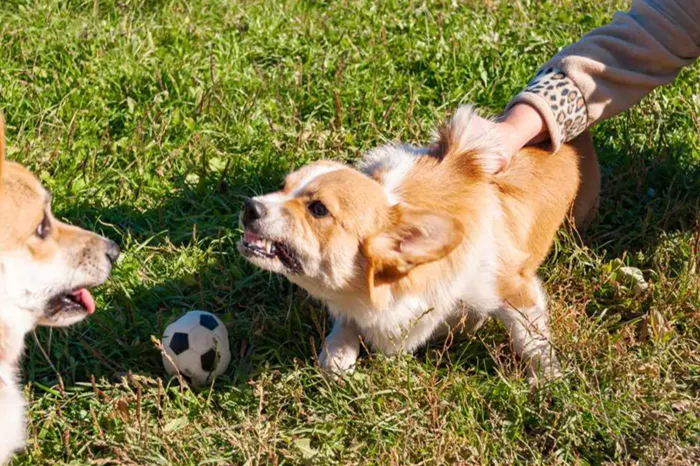Corgis were originally bred as herding dogs. Their natural instincts include chasing and nipping at the heels of animals. This herding behavior often translates into playful but persistent biting in puppies.
Teething and Discomfort
Teething typically begins around 3 weeks and can last up to 6 months. During this time, your corgi puppy may bite to relieve gum discomfort. This behavior is natural but must be guided early.
Play and Exploration
Biting is a common way for puppies to explore the world. They use their mouths to interact and communicate. It is crucial to teach them what is acceptable and what is not.
When to Start Bite Training
The Sooner, the Better
Start training your corgi puppy as early as 6 to 8 weeks old. At this age, they are most receptive to learning. Early intervention can prevent long-term behavioral issues.
Consistency Is Key
Daily training sessions help reinforce proper behavior. Short, repeated training is more effective than occasional long sessions.
Essential Tools and Supplies
Safe Chew Toys
Provide a variety of chew toys. Toys that mimic real textures, like rubber bones or knotted ropes, can divert biting behavior from hands and feet.
Treats for Positive Reinforcement
Use small, healthy treats to reward good behavior. Reinforcement encourages your puppy to repeat desirable actions.
Clicker for Clicker Training
A clicker provides a consistent sound to mark correct behavior. When used with treats, it helps build strong behavior-reward associations.
Step-by-Step Guide to Train Your Corgi Puppy Not to Bite
Step 1: Use a Firm “No”
When your puppy bites, stop play immediately. Say “No” firmly and clearly. Do not yell or frighten them. Calm but serious tones work best.
Step 2: Redirect the Bite
Offer a toy as a replacement. This teaches your puppy that toys are acceptable for biting, not hands or clothing.
Step 3: Withdraw Attention
If your puppy continues to bite, stand up and turn away. Stop all interaction for a few minutes. This teaches that biting ends fun.
Step 4: Apply Gentle Timeouts
Use short, 1-minute timeouts in a quiet area when biting persists. Timeouts are effective when used sparingly and consistently.
Step 5: Reward Good Behavior
Praise and treat your corgi puppy when they play without biting. This reinforces calm, respectful interaction.
Common Mistakes to Avoid
Don’t Use Physical Punishment
Never hit or slap your puppy. This may lead to fear-based aggression or anxiety.
Don’t Laugh at Biting
Puppies are highly responsive to tone. Laughing may signal that biting is encouraged or part of a game.
Don’t Allow Rough Play
Avoid roughhousing that includes hands or feet. Such games often confuse your puppy about what’s acceptable.
Advanced Techniques for Persistent Biters
Mouthing Inhibition Training
Allow your puppy to bite gently and say “Ouch!” when it gets too hard. Then stop play. Over time, your puppy learns to control bite pressure.
Clicker and Treat Protocol
Click and reward when your corgi plays without using teeth. Gradually extend the duration before rewarding. This builds longer periods of bite-free play.
Enroll in Puppy Training Classes
Professional puppy classes offer structured environments. They provide Professional Dog Training Method programs tailored to young dogs.
Creating a Bite-Free Environment at Home
Set Clear Boundaries
Everyone in the household must follow the same rules. Consistency prevents confusion and speeds up learning.
Maintain a Calm Atmosphere
Overstimulation often leads to biting. Keep training environments calm and predictable.
Control High-Energy Moments
During zoomies or playtime, your puppy may forget manners. Have toys ready and be prepared to calmly intervene.
Socialization to Reduce Aggressive Biting
Expose to Various People
Introduce your puppy to children, adults, and seniors. Diverse exposure teaches bite inhibition in different scenarios.
Monitor Play with Other Dogs
Supervised play with calm, well-trained dogs helps teach boundaries. Older dogs will often correct bad puppy behavior naturally.
Use Controlled Playdates
Set up short and safe playtimes with dogs known for gentle behavior. Always watch closely and stop the session if play gets too rough.
Tracking Progress and Setting Expectations
Be Patient
Progress varies by puppy. Some corgis respond quickly, while others need more time.
Use a Training Journal
Record daily results, techniques used, and observed changes. This helps you spot patterns and make informed adjustments.
Celebrate Milestones
Notice when biting decreases. Offer praise and occasional special treats. Progress deserves recognition.
When to Seek Professional Help
Signs You Need Help
Seek help if your puppy shows signs of aggression, growling, or biting that draws blood. A certified trainer can assess and assist.
Find a Certified Trainer
Choose a trainer who specializes in positive reinforcement. Review credentials and testimonials before committing.
Conclusion
Training your corgi puppy not to bite takes consistency, patience, and understanding. Use safe tools, reward positive behavior, and avoid punishment. By setting clear boundaries and offering gentle guidance, your corgi will grow into a friendly, bite-free companion. With the right methods and dedication, even the most playful puppy can learn good manners and control.
Related topics:
How Much Should a Yorkie Puppy Eat a Day
How Much to Feed a Corgi Puppy


